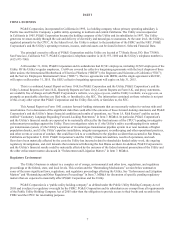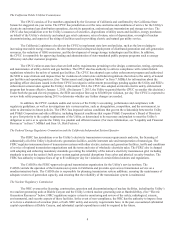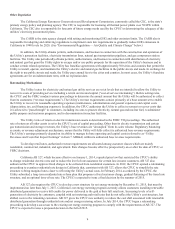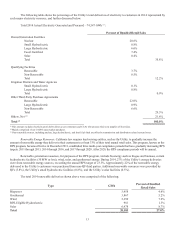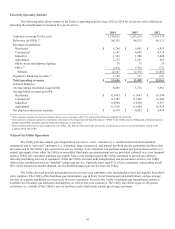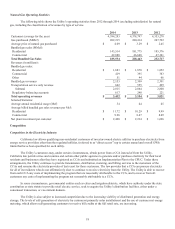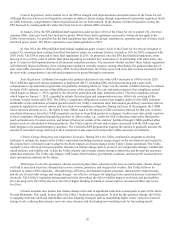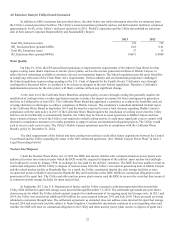PG&E 2014 Annual Report Download - page 22
Download and view the complete annual report
Please find page 22 of the 2014 PG&E annual report below. You can navigate through the pages in the report by either clicking on the pages listed below, or by using the keyword search tool below to find specific information within the annual report.
14
Energy Storage. As required by California law, the CPUC has established initial energy storage procurement targets to
be achieved by each load-serving entity, such as the Utility. The Utility has an 80.5 MW of energy storage target to meet its 2014
energy storage plan. In December 2014, the Utility held its first competitive request for two types of proposals: (1) an energy
storage agreement with the owner of an energy storage facility that would enable the Utility to offer stored energy into the CAISO
market and (2) a purchase and sale agreement under which the counterparty would build a storage facility and transfer the facility
to the Utility provided the facility meets certain operational conditions. Offers are due by February 17, 2015. The Utility intends
to complete negotiations and execute contracts by October 1, 2015 and to submit the executed contracts for CPUC approval by
December 1, 2015.
Owned Generation Facilities. At December 31, 2014, the Utility owned the following generation facilities, all located in
California, listed by energy source and further described below:
Generation Type County Location Number of
Units
Net Operating
Capacity (MW)
Nuclear (1):
Diablo Canyon San Luis Obispo 2 2,240
Hydroelectric (2):
Conventional 16 counties in northern and central
California 104 2,677
Helms pumped storage Fresno 3 1,212
Fossil fuel-red:
Colusa Generating Station Colusa 1 657
Gateway Generating Station Contra Costa 1 580
Humboldt Bay Generating Station Humboldt 10 163
Fuel Cell:
CSU East Bay Fuel Cell Alameda 1 1
SF State Fuel Cell San Francisco 2 2
Photovoltaic (3): Various 13 152
Total 137 7,684
(1) The Utility’s Diablo Canyon power plant consists of two nuclear power reactor units, Units 1 and 2. For the year ended December 31, 2014, the Utility’s Diablo
Canyon power plant achieved an average overall capacity factor of approximately 87%. The ability of the Utility to produce nuclear generation depends on the
availability of nuclear fuel. The Utility has entered into various purchase agreements for nuclear fuel that are intended to ensure long-term fuel supply. (See
Note 14 to the Consolidated Financial Statements in Item 8.) The Diablo Canyon power plant refueling outages are typically scheduled every 20 months. The
average length of a refueling outage over the last five years has been approximately 49.5 days. The actual refueling schedule and outage duration will depend on
the scope of the work required for a particular outage and other factors. The NRC operating licenses for the two operating units at Diablo Canyon include various
license conditions related to seismic design and safety. The current licenses expire in 2024 and 2025. In November 2009, the Utility filed an application with the
NRC to seek the renewal of the licenses, a process which can take several years. After the March 2011 earthquake in Japan that damaged nuclear facilities, the
NRC granted the Utility’s request to delay processing its renewal application until certain advanced seismic studies of the fault zones in the region surrounding
Diablo Canyon were completed. The seismic studies have been completed and in September 2014, the Utility submitted a report to the NRC and the CPUC’s
Independent Peer Review Panel that confirmed the seismic safety of the plant. The Independent Review Panel is providing comments on the report and the Utility
expects its review to be completed within the next six to eight months. (See also “Environmental Matters” and Item 1A. Risk Factors.)
(2) The Utility’s hydroelectric system consists of 107 generating units at 67 powerhouses. All of the Utility’s powerhouses are licensed by the FERC (except for three
small powerhouses not subject to FERC licensing requirements), with license terms between 30 and 50 years.
(3) The Utility’s larger operational photovoltaic facilities include the Five Points solar station (15 MW), the Westside solar station (15 MW), the Stroud solar station
(20 MW), the Huron solar station (20 MW), the Cantua solar station (20 MW), the Giffen solar station (10 MW), the Gates solar station (20 MW), the West Gates
solar station (10 MW) and the Guernsey solar station (20 MW). All of these facilities are located in Fresno County, except for the Guernsey solar station, which is
located in Kings County.
Generation Resources from Third Parties. The Utility has entered into various agreements to purchase power and electric
capacity, including agreements for renewable energy resources, in accordance with its CPUC-approved procurement plan. (See
“Ratemaking Mechanisms” above.) For more information regarding the Utility’s power purchase agreements, see Note 14 of the
Notes to the Consolidated Financial Statements in Item 8.
Electricity Transmission
At December 31, 2014, the Utility owned approximately 18,100 circuit miles of interconnected transmission lines
operating at voltages ranging from 60 kV to 500 kV. The Utility also operated 91 electric transmission substations with a capacity
of approximately 63,400 MVA. The Utility’s electric transmission system is interconnected with electric power systems in the





